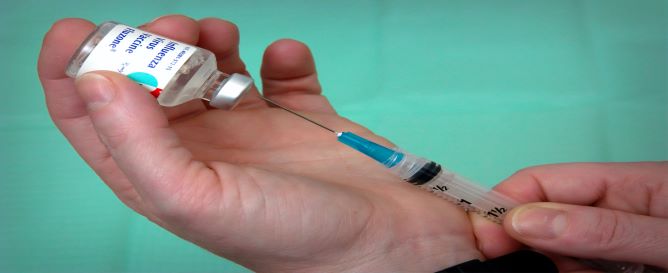Storing Covid-19 Vaccines, and The Importance of Temperature Monitoring

Walk-In Cooler Temperature Monitoring
November 25, 2020
The Importance of Warehouse Temperature and Humidity Monitoring with Wireless Sensors
April 7, 2021COVID-19 has been affecting the citizens of the world since December of 2019. We have lost people to this disease, but many have been able to recover from it with other treatments. However, now there are vaccines to help treat and prevent COVID-19. Companies such as Pfizer-BioNTech, AstraZeneca, Janssen, and Moderna will be releasing their versions of the vaccine between December 2020 and February 2021. They are all encouraging everyone to get a vaccine to help stop the spread of COVID-19.
Here is an outline of the most promising COVID-19 vaccines in development, when they are being released, and what you need to know about the importance of temperature monitoring. While the world has let out a great sigh of relief at hearing about the release of COVID-19 vaccines, we must be diligent and keep the vaccines viable by storing them at the appropriate temperature. You should know that the different versions of the COVID-19 have their own special recommendations and requirements for what temperature they must be stored at.

Pfizer-BioNTech
Pfizer's vaccine has already begun to be distributed to large areas of Europe and all over the United States. More than 165 countries will be getting this vaccine in the next few months. They have voiced their confidence in their ability to get their vaccine out quickly and in large amounts of high-quality packaging.
Their vaccines have been delivered to healthcare facilities frozen at -70C, so they are ready to go to vaccinate right away. Distribution is being sent largely from their Kalamazoo, Michigan site directly to the point of use locations. They will also be using their other distribution location site in Pleasant Prairie, Wisconsin.
Road and airline transportation has been being used in the United States, meaning healthcare facilities within a day or two. Europe locations may take an extra day or two to get there. Pfizer has been found quoting their vaccine is "90% effective." Their vaccines have been dubbed by the Joint Committee to be given to those above 80 years of age, healthcare workers, and care home residents.
Here are fact sheets for the Pfizer-BioNTech product approval for the emergency use authorization for COVID-19:

Moderna
The FDA issued an emergency use for the Moderna vaccine to be used against COVID-19 on December 18, 2020. This was the first vaccine to prevent COVID-19 that the FDA did approve. The vaccine will be used on those 18 years and older. Like the research from the other companies, this vaccine will require a second dose one month after the first, similar to other vaccines.
Moderna tested their vaccine trial on 15,400 people, 18 years and older, with only 1 dose. The effective rate is 94.1%, based on the 196 conducted cases. The final phase of Moderna's vaccine was completed with the help of 30,000 volunteers age 18 and older in the U.S. on October 22, 2020, including those who were at high risk of complications of COVID-19. The study also used the help of 7,000 American volunteers age 65 and older.
High-risk volunteers made up 42% of the total participants in their third phase study. They included more than 11,000 volunteers from communities of color and 6,000 who identify as Hispanic or Latino.
200 million doses have been ordered by the U.S. Government, and they have opted for an additional 300 million doses. By the end of December 2020, 20 million doses will have been delivered.
They have continued to collect data and are planning on filing a Biologics License Application with the FDA to get a full license by 2021. The DoD, DHHS, and CDC will be managing all of the distribution of the vaccines in the U.S. Prioritizing will be conducted by the CDC's Advisory Committee on Immunization Practices, and they will decide who will be the next group to be vaccinated.
Moderna's vaccine does come with some reactions after the 2-dose series such as pain at the injection site, erythema, swelling, and ipsilateral lymphadenopathy. Most were put as a mild to moderate occurrence, with a few after the second injection as severe reactions. The reactions occurred one to two days after the injection and persisted for one to two more days.
The vaccine from Moderna has been unanimously voted as a recommendation to the citizens of the United States by the CDC. Their vote won 11 to 0 in support of this vaccine. The CDC is hoping to get the vaccine out between 125 and 200 more million doses for U.S. citizens by the first quarter of 2021. The reason for this vote was because of multiple reports showing those who had already gotten Pfizer's vaccine had mild to severe anaphylaxis, meaning they were allergic to the vaccine or the ingredients of the vaccine.

AstraZeneca
The Oxford-AstraZeneca vaccine has yet to be approved by the CDC, Joint Committee, and MHRA, but the vaccine has been going through rounds of testing on a small group of those under 55, showing it is 70-90% effective. Oxford-AstraZeneca has taken a weakened strain of the common cold from a chimpanzee and modified it to look like COVID-19, but it would not cause illness. Injected into the volunteer, it will prompt their immune system to make antibodies to fight the COVID-19 infection.
Oxford University researchers have been working on this vaccine before 2020 because it can be modified and changed to combat against multiple types of diseases, not just COVID-19. They discovered the same vaccine could be adapted to fight off COVID-19 infections too.
The United Kingdom has already ordered 100 million doses, and other countries such as Malaysia have signed contracts and deals with Oxford-AstraZeneca for their vaccines. Many countries are siding with this vaccine instead of Pfizer's because it can be stored in a refrigerator instead of having to be kept at -70C. Chances of these countries getting the vaccine by the beginning of the year have been quoted as "pretty high."

Janssen
Janssen, the makers of Johnson & Johnson products, have been working on their own COVID-19 vaccine. They decided to do their trial in 3 parts, with the last stage coming in later than they were expecting. They have enrolled around 45,000 volunteers for this last phase of their trial, they announced a cut from 60,000 because of higher COVID-19 cases. Janssen has released an update that they will have all of the data they will need by late-January, with hopes of administering it in February as long as the FDA approves, and their data shows it is safe and effective.
In the race for vaccines for the millions of people around the globe, Janssen is behind their competitors, sitting way behind Pfizer, Moderna, and AstraZeneca. Seeing as they are a drug-making company, a lot of citizens globally thought their vaccine would be the first to be released.
Another setback happened in October when one patient developed an "unexplained illness" during their study, this halted the trials for over a week. The trial resumed after an evaluation was conducted, showing there was not any cause of the illness.
This final and late phase of Janssen's vaccine will be the exploration of a two-dose regimen. They have decided to investigate further into their own studies before they release any data from their volunteers from all 3 phases to the Joint Committee and the FDA.
Understanding the Importance of Temperature Monitoring in Relation to Vaccine Storage
Why a temperature monitoring system is such an important factor in relation to vaccine storage? If the temperature in the units containing the vaccine changes, it could ruin the vaccine. That means thousands, tens of thousands, hundreds of thousands, or even millions of dollars’ worth of vaccines could be wiped out and destroyed because there was a change in temperature when they were in storage.
According to the CDC’s recommendations, anytime there is a change in temperature when vaccines are in storage, adjustments need to be made immediately. The CDC recommends regular temperature checks(page 12) to ensure that the vaccines are still viable.It took a great deal of time, effort, and money to develop the COVID-19 vaccines that are being released. People around the world have been on the edge of their seats waiting, hoping, even praying for these vaccines. The release of the COVID-19 vaccines by companies like Pfizer has been greatly anticipated and the announcement of their successful development has brought hope to millions of people around the globe.
Remember, without these vaccines, life as we know it would never be able to return to normal. Even with the vaccines in place and being released, the effects that COVID-19 has thrust upon society will likely remain in effect for some time.
Going back to normal too soon would be potentially hazardous and jeopardize millions. It would also be an insult to the scientists who have spent countless hours of their lives working to develop a vaccine to set things right and back on course. Likewise, it would be equally hazardous to store vaccines improperly.
When a vaccine is exposed to improper temperatures it is essentially ruined and made completely ineffective if not unsafe.
The trouble with keeping vaccines at the right temperature is knowing when the temperature changes. The single most effective way to stay on top of it is to invest in temperature monitoring solutions. By monitoring the temperature of the vaccines in storage constantly, there is no room for error. The best and most effective temperature monitoring solutions can notify you whenever the temperature changes so that it can be remedied before any major damage is incurred.
Constant temperature monitoring is arguable preferable to mere regular temperature checks for obvious reasons. If you check the temperature of the vaccines every hour or so it does you no good if the temperature changes within ten minutes of the last check. This means the vaccines could be compromised and ruined by the time you return in another hour for the next temperature check.
Handling the Storage of Vaccines Properly
Temperature aside, all vaccines should be stored properly which means keeping them in their original packaging until they are ready to administer. Whenever someone sees a notification that the temperature in the storage area is off, they are to communicate the discrepancy to the primary or alternate vaccine coordinator ASAP. Alternatively, they can report the problem to their supervisor.
Active maintenance of the vaccines is paramount. You simply cannot just put them in storage and leave them be expecting everything to be fine, that does not happen, and it is unacceptable. You must take responsibility to care for the vaccines and keep them in good condition. There are of course tools and systems for making this responsibility easier.
TempGenius is a favored solution for temperature monitoring that can help make your job easier when it comes to maintaining the proper temperature to store COVID-19 vaccines.
Store Your Vaccines the Smart Way, with TempGenius
TempGenius offers a safe, secure, and effective way to store vaccines. Our packages meet the CDC’s temperature monitoring guidelines and feature NIST calibrated 4 Wire RTD probe in a Glycol Solution.
If the conditions in the units you are storing the vaccine changed, how would you know? The temperature could rise or drop without any warning and ruin the valuable vaccines contained inside. When you use TempGenius, you will be instantly notified whenever there is a change in the conditions that could imperil the vaccines. Keep the COVID-19 vaccines safe and sound with round-the-clock temperature monitoring technology from TempGenius!
Stay in compliance with reliance on TempGenius, ask our experts about the benefits today!

